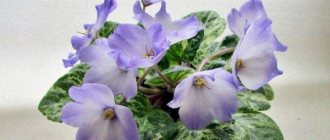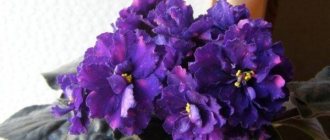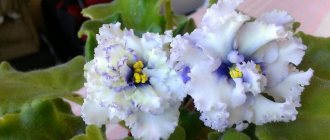Violets are popular and beautiful indoor plants. To grow Saintpaulias, you need to know what pests can affect them and how to deal with them.
The most dangerous and difficult parasites to remove are thrips: on violets they can go through all stages of development and cause irreparable harm to other indoor flowers.
What are thrips and how do they threaten plants?
Thrips are small insects that feed on plant sap. They go through 5 stages of development: from egg to adult. 1 female is capable of laying 1,000 eggs at a time. There are more than 2,000 species of these insects, and 360 of them live in the territory of the former USSR.
Adults have an oblong body and transparent wings. The size of the pests does not exceed 1-1.5 mm, but there are also smaller species of thrips that are more difficult to see. Parasites have different colors: black, gray, white, yellowish, etc.
The life cycle of insects is 35 days. They can develop in different conditions. For example, in the soil, on the surface of the plant or in its tissues, where the eggs are completely safe. Insects are capable of multiplying quickly, and this greatly complicates the fight against them.
Since pests feed on plant sap and tissue, they are capable of destroying a completely healthy flower in a short time. The larvae open the anthers on the peduncles, and the adults bite through the flower tissue and suck out the nutrients.
In addition, insects also attack vegetable crops, since they reproduce throughout the year. When growing seedlings on a windowsill, it is important to prevent them from multiplying.
The most popular varieties
The most common, both among experienced flower growers and novice collectors, are:
- The bride's bouquet;
- White Sun of the Desert;
- White mustang;
- White Nights;
- White magic;
- Lady in White;
- Juliet;
- Cotton candy;
- White angel;
- Your Mightiness.
House violet (Saintpaulia ionantha)
If you have not grown violets yet, then you should start with an ordinary indoor Saintpaulia. Outwardly, it is similar to the purple flower that in 1892, during a walk with his bride, was discovered by the military commandant of the Uzambara district of German East Africa, Baron Walter von Saint-Paul. He sent the seeds to his father, who headed the German Dendrological Society. Ulrich von Saint-Paul, in turn, gave them to the botanist Hermann Wendland, who introduced the flower to the world, calling it Saintpaulia in honor of his father and son.
Since then, the Uzambara violet has spread throughout the planet. It is a perennial herbaceous plant with a large rosette and short fleshy stems. Saintpaulia leaves are dark green, heart-shaped, up to 8 cm long, and the flowers are blue-violet.
Apple orchard
Saintpaulias can be of various sizes: from giants (with a rosette diameter of 40-60 cm) to miniature (a rosette up to 6 cm in diameter). Such mini violets include the Yablonevy Sad variety, bred in 2012 by A. Kuznetsov.
Delicate white flowers edged with pink cover a small rosette of dark green leaves. Violet blooms profusely: on each peduncle there are up to a dozen flowers, 2-3 cm in diameter.
Excess fertilizer and sun can lead to flowers turning purple, so shade the plant and do not overdo it with fertilizing.
Vampires Kiss
A variety for experienced gardeners, because... difficult to grow, and this violet grows very slowly. But the work will pay off handsomely: with each flowering, Saintpaulia becomes more beautiful. It has large dark burgundy semi-double flowers with an almost black border. The leaves are dense, pubescent, dark green in color, and can easily break off.
Flowering lasts a long time, the flowers do not fade for about a month, and lighten over time.
Queen Sabrina
There are violets that combine several varieties. Their subspecies is called the chimera. The petals of such violet flowers have two genetic layers with different colors. Queen Sabrina is also a semi-miniature chimera.
Its large, double, coral-pink flowers have a blue stripe in the center of each petal. The rosette is small (15-17 cm in diameter) with dark green, slightly quilted leaves. Violet always blooms profusely, and with age it becomes even brighter.
It can be negatively affected by the heat, due to which the flowering period is reduced.
Sea Wolf
Giant blue flowers with semi-double corollas, reminiscent of bells, look spectacular against the backdrop of large dark green foliage. This is how the violet variety Sea Wolf, bred by E. Korshunova, appears before us. The flower petals are wavy with a graceful mesh pattern and a white-green edge.
Unlike other violets, it is better to grow a flower of this variety on a well-lit windowsill or loggia.
Blue Dragon
These large double and semi-double light blue violets are recognized not only by the huge size of their corollas, but also by the green border on their wavy petals. Moreover, the border is brighter and wider in cool conditions, but in the heat it is practically absent.
Violets of the Blue Dragon variety are characterized by a powerful rosette (up to 40-50 cm) with dark green leaves, which have jagged edges and a reddish back side. A plant of such impressive size requires increased nutrition and space, so the “dragon” will not tolerate “neighbors” on the windowsill.
Esmeralda
The petals of the violet, named after Victor Hugo’s heroine, resemble the wavy hem of a gypsy skirt. This variety is in the collection of two breeders S. Repkina and E. Lebetskaya. The first one has a bright cherry corolla color, the second one is the color of fuchsia or ripe raspberry. The edges of the petals are white.
Large lush flowers look advantageous against the background of evenly colored foliage.
RS Don Juan
The violet bred by S. Repkina bears the name of another literary hero. Large semi-double flowers of purple-plum color are framed by a wide wavy border of golden color. The leaves are large, as is the rosette, which even in young plants reaches 40 cm.
The variety is unpretentious, is not afraid of temperature changes, but loves bright lighting and frequent moderate watering.
How to recognize that a violet is infected with thrips
Since thrips are one of the most common problems, you need to know and be able to recognize the main signs of their parasitism on Saintpaulias:
- pollen is actively falling off on flowers;
- the leaves begin to curl and lose their elasticity;
- white or gray blotches and spots appear on the leaf plate;
- the buds fade before they have time to open, and the flowers wither and darken;
- a sticky coating forms on the surface of the plant;
- the leaves darken and fall off.
Some of the signs above may indicate other problems. Therefore, if similar symptoms and signs appear, you need to carefully examine the violet from all sides. This will allow you to detect either adults or their larvae.
Fighting methods
Thrips are quite difficult to remove, therefore, having noticed them, it is necessary to immediately begin violet treatment. To kill insects, they use special pesticides designed to combat persistent parasites on plants, and these are pests on violets such as mites, thrips, scale insects, etc.
For highly effective treatment, flower growers recommend using a set of measures to destroy and prevent thrips. Control methods include the following mandatory actions:
- The first thing to do is to identify the infected flowers and isolate them from healthy Saintpaulias by moving them to another room.
- If the plant has flower stalks, it is advisable to cut them off and dispose of them, since the pest larvae often live in flowers and buds.
- Before starting chemical treatment, the violet must be washed under warm water.
- The chemical should be diluted according to the instructions and, taking all precautions, spray the plant with a spray bottle.
- After systematic treatment, it is necessary to carry out the usual care for violets, but the violets should be placed in another room until there is complete confidence that the pests have been exterminated.
This type of insect is resistant to various chemicals. This is due to the fact that people do not completely poison the parasites, which survive and subsequently become resistant to one or another drug.
Flower growers recommend systematically poisoning thrips for 1 month. During this time, those larvae that were safe at the time of chemical treatment may degenerate.
In pest control, non-standard approaches are often used. For example, use a solution of zoo shampoo and water.
Green soap
A popular remedy for pests is the insecticide green soap. It is produced on the basis of potassium salt of fatty acids and has a contact effect.
The drug will help exterminate the parasites living on Saintpaulias; green soap can be used in its pure form, diluted and mixed with other chemicals.
During processing, the active substance forms a film on the insect’s body that envelops it and blocks the respiratory tract.
To work with the insecticide, you must use only glass or porcelain containers.
Dimetris
Many methods of pest control, including thrips, can be found on the page of the Dimetris flower growing community. They have a whole section with information dedicated to combating parasites and other diseases of violets.
Saintpaulia treatment must be carried out not only systematically, but also by changing preparations. It is recommended to choose flower treatment products with different active ingredients. It is believed that this approach will increase the effectiveness of pest control.
Other drugs
A popular drug for pest control is Aktara. Thrips can develop resistance to the active substance over time, so gardeners recommend treating with a concentrated solution of the product.
In combination or separately, such drugs as Fitoverm, Vertimek, Confidor, Tanrek, Agravertin, etc. are used.
Ticks
Mites are microscopic pests that are very difficult to detect on a plant with the naked eye. Most often, violets are parasitized by the cyclamen mite, the transparent greenhouse mite, or the strawberry mite. These parasites prefer high humidity. They feed mainly in the center (rosette) of the plant.
Symptoms
If there is a mite on the violets, then small depressed spots colored brown or red will be observed on the underside of the outer leaves. These places may be shrouded in a thin cobweb. The leaves begin to deform, become brittle and dry out after a while. The central part of the rosette becomes denser, the violet noticeably lags behind in growth and development. The buds stop forming.
At the same time, the leaves look more pubescent than before, and roughness can be felt on the villi. The foliage becomes dull, the stem noticeably shortens. Pollen begins to spill out of the anthers.
Treatment
In order to get rid of mites on violets you need to:
- Gently rinse the plants under running water - this way you will be able to remove a significant number of adults and egg laying;
Important! Cool water should not be used, especially if the plants were kept at a constant temperature of +18..22°C. Otherwise, Saintpaulia can catch a cold!
- spill and spray infected specimens with a solution of the drug “Fitoverm” or “Agravertin”; in case of severe infection, it is better to use “Neoron”;
- for greater efficiency, it is recommended to add a little liquid soap to the working solution;
- after 10 days, re-treat;
- in the future, regularly “bathe” the plants, especially in hot and dry weather;
- try to place violets away from each other.
How to avoid thrips
The most effective method of controlling any pests is prevention. In order to prevent the appearance of thrips, it is recommended to follow simple preventive measures:
- Do not allow excessive dry air in the room where the flowers are placed.
- During treatment and in the summer, periodically bathe Saintpaulia under running warm water.
- Place all new indoor plants in another room for quarantine (about a month), and place vases with bouquets away from violets.
- Inspect Saintpaulias regularly, paying close attention to the undersides of the leaves and the middle of the flowers.
If you find pests on your favorite flowers, there is no need to worry, but it is better to immediately begin treatment. It is imperative to systematically treat sick Saintpaulias at least 5 times every 5-7 days.











